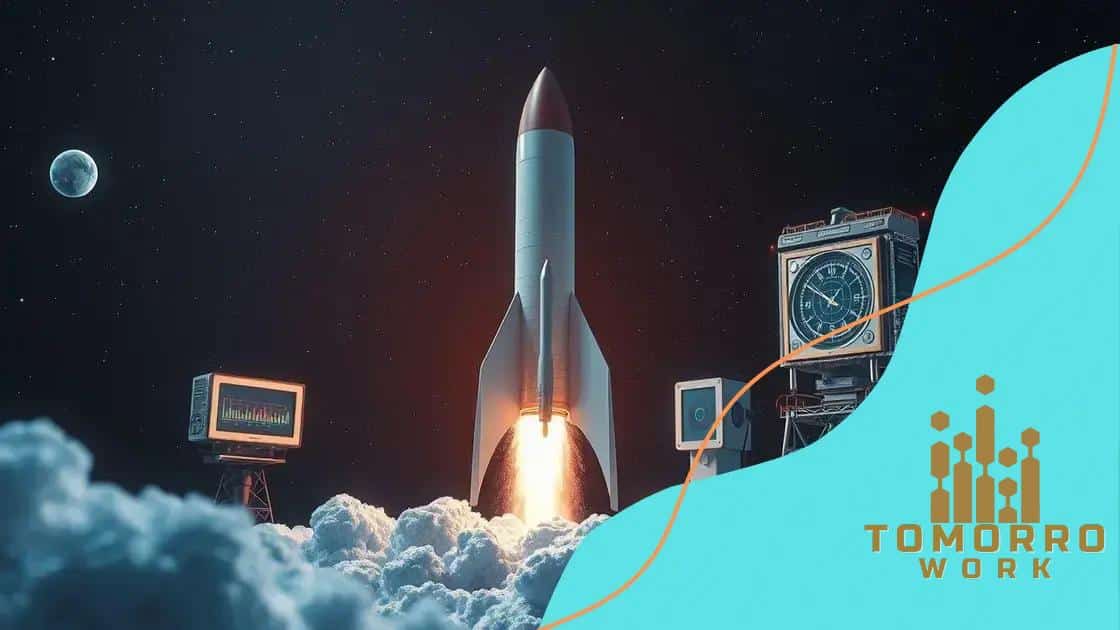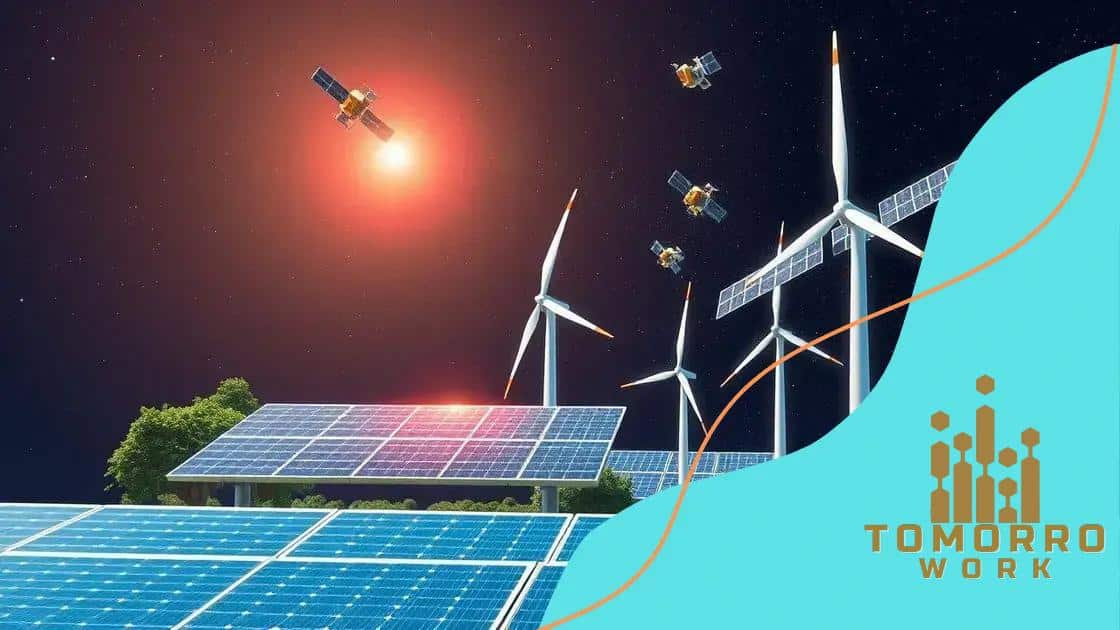How space exploration is shaping technological innovation

Advertisements
Space exploration drives technological innovation by inspiring advancements in robotics, materials, and renewable energy, leading to solutions that enhance efficiency and sustainability on Earth.
How space exploration is shaping technological innovation may surprise you. It’s not just about rockets; it’s about how everyday tech evolves from these cosmic quests. Curious about how these connections work? Let’s dive in!
Advertisements
The role of satellites in daily technology
Satellites play a crucial role in shaping our daily lives. From navigating the streets to predicting the weather, their impact is enormous. Understanding how satellites function reveals their importance in various technologies.
Communication Technologies
Satellites are essential for modern communication. They enable TV broadcasts, internet connectivity, and mobile communications. This technology ensures that people stay connected, no matter where they are.
- Global Positioning Systems (GPS) for navigation
- Satellite television providing diverse programming
- Satellite phones for remote communication
This interconnectedness allows for seamless communication across vast distances. It’s impressive to think about how much we rely on these orbiting devices every day.
Advertisements
Weather Forecasting
Another key aspect is weather forecasting. Satellites gather data on cloud patterns, temperature, and moisture levels. This information is vital for predicting storms, climate changes, and other weather-related events. People can plan their activities with better accuracy.
For instance, meteorologists analyze satellite imagery to provide timely and precise forecasts, which can save lives during severe weather. With this data, many can make informed decisions to stay safe.
The role of satellites extends beyond communication and weather. They also contribute to scientific research. Satellites collect data about environmental changes, helping scientists monitor climate patterns and resource management.
- Studying deforestation and urban growth
- Tracking ocean currents and temperatures
- Examining atmospheric conditions for climate studies
This data is crucial for creating strategies that aim to protect our planet. Overall, satellites enhance our daily lives and drive technological progress.
How space missions drive medical advancements
Space missions have a surprising impact on medical advancements. The challenges of space travel lead to innovative solutions that improve health care on Earth. For instance, the need to monitor astronauts’ health in space has resulted in advanced medical technologies.
Telemedicine Innovations
In space, doctors cannot be physically present with astronauts. This necessity has pushed the development of telemedicine. Now, doctors can provide remote care using technology. This is beneficial not only for astronauts but also for patients in remote areas on Earth.
- Real-time health monitoring from a distance
- Remote diagnosis and consultations
- Use of video conferencing for patient care
These advancements help ensure that patients receive timely care, regardless of location, showcasing how space technology goes beyond beyond our atmosphere to save lives.
Materials for Health Devices
Space missions also contribute to better medical devices. The materials developed for space exploration are often lightweight, durable, and able to handle extreme conditions. These materials are used in various health care tools, enhancing their effectiveness.
For example, new imaging technology for X-rays and MRIs benefits from innovations originally designed for space equipment. This makes diagnostic tools faster and more accurate, which is crucial in medical settings.
Moreover, advances in robotics for space missions support the development of surgical robots. These robots perform precise surgeries, reducing recovery times for patients. As a result, patients can get back to their daily lives quicker, thanks to these space-driven innovations.
- Improved surgical techniques with robotic assistance
- Enhanced imaging systems for diagnostics
- Creation of better prosthetics using space-grade materials
Ultimately, the synergy between space exploration and medical advancements illustrates how exploring beyond our planet can lead to impactful changes in health care.
The surprising link between space and renewable energy

The relationship between space and renewable energy may not be immediately obvious, but it has become increasingly important. Innovations developed for space exploration are influencing the way we harness energy from natural resources.
Solar Energy Advancements
One of the most significant breakthroughs is in solar energy. Space missions require efficient energy sources, leading to the development of advanced solar panels. These panels are designed to capture sunlight more effectively, and this technology is now being used on Earth.
- High-efficiency solar cells with improved design
- Thin-film solar technologies that reduce costs
- Solar energy systems designed for various environments
By implementing these technologies, we can produce cleaner energy while also reducing costs. The advancements also encourage wider adoption of solar power, which is essential for a sustainable future.
Wind Energy Technologies
Besides solar, space-related innovations are impacting wind energy. Research into high-altitude wind patterns has resulted in new methods for harnessing wind energy more efficiently. Learning from wind patterns in the upper atmosphere can help optimize wind turbine placement and performance.
Engineers are utilizing data collected from satellites to make informed decisions on wind farm locations. This technology can lead to increased energy production and lower operational costs.
Furthermore, some space agencies are exploring the idea of solar power satellites. These satellites could collect solar energy in space and beam it back to Earth. This concept has the potential to revolutionize the energy industry and provide a continuous energy supply without dependence on weather conditions.
- Development of solar power satellites
- Utilization of orbital solar energy collection
- Innovations in energy transmission technologies
This visionary approach highlights how space exploration can inspire solutions for renewable energy challenges. By looking beyond our planet, we can gain valuable insights that may power our future.
Innovative materials developed for space travel
Innovative materials developed for space travel have transformed not only the aerospace industry but also everyday products we use on Earth. These advancements come from the need to withstand the extreme conditions of space.
Lightweight and Durable Materials
One of the significant breakthroughs is the creation of lightweight materials that are strong enough to endure the harsh environment of space. For example, materials like carbon fiber and aluminum alloys have become widely used in spacecraft construction.
- Carbon fiber composites for reduced weight
- Advanced aluminum alloys that offer superior strength
- Heat-resistant ceramic materials for re-entry protection
These materials not only enhance the performance of spacecraft but also help in conserving fuel, making missions more efficient.
Thermal Protection Systems
During re-entry into the Earth’s atmosphere, spacecraft encounter extreme heat. Innovative thermal protection systems are crucial for ensuring the safety of astronauts and equipment. Heat shields made from specialized materials like ablative composites absorb and dissipate intense heat, protecting the craft.
By developing these systems, space agencies ensure that spacecraft can withstand the temperatures exceeding thousands of degrees. This technology is even making waves in automotive and building materials as manufacturers seek heat-resistant options.
Furthermore, innovations in flexible materials have emerged, allowing for adaptable structures. These materials can change shapes or properties under different conditions, enabling better functionality for spacecraft.
- Flexible solar panels that maximize energy capture
- Smart fabrics that monitor astronaut health
- Recyclable materials for sustainable missions
Such innovations not only advance space exploration but also emphasize sustainability and efficiency, paving the way for future technologies across various fields.
Future technologies inspired by space exploration
Future technologies inspired by space exploration promise to reshape our world in exciting ways. The challenges of living and working in space push scientists and engineers to develop innovative solutions. These advancements often find applications back on Earth, benefiting various industries.
Robotics and Automation
One significant area is robotics and automation. Space missions require precise and reliable robotic systems for tasks such as assembling structures or conducting repairs. These innovations have led to advancements in robotic technology used in homes and industries.
- Robotic arms for surgery that enhance precision
- Autonomous drones for delivery and surveying
- Assistive robots for elderly care and companionship
As these technologies evolve, they make our lives easier and improve safety in various fields, showcasing how space challenges lead to essential innovations.
Smart Materials
Another exciting area is the development of smart materials. In space, materials must perform under extreme conditions. Research into these materials has opened pathways to create responsive textiles and surfaces that adjust to environmental changes.
Smart textiles can regulate temperature or even monitor health. This technology has potential applications in fitness gear and medical wearables, providing real-time data about the user’s health.
Moreover, the development of 3D printing technology for manufacturing parts in space has significant implications for sustainable practices on Earth. It allows for on-demand production and reduces waste, transforming supply chains and construction processes.
- Additive manufacturing for custom products
- Eco-friendly building materials designed for 3D printing
- Scalable production methods for various industries
The exploration of space drives us to think creatively about solutions and materials that improve life on Earth. It reminds us that the quest for knowledge and advancement can lead to innovations that impact our everyday lives.
In conclusion, the advancements driven by space exploration have profound implications for our world. The technologies developed for space missions not only enhance our ability to explore but also lead to innovations that improve our daily lives. From revolutionary materials and medical advancements to renewable energy solutions, the benefits are vast. As we continue to explore the universe, we can expect even more transformative technologies that will make life on Earth better and more sustainable.
FAQ – Frequently Asked Questions about Space Exploration and Technology
How does space exploration drive technological advancements?
Space exploration creates challenges that require innovative solutions, leading to new technologies that often benefit life on Earth.
What are some materials developed for space travel?
Innovative materials include lightweight composites, heat-resistant ceramics, and smart textiles, all designed to withstand extreme space conditions.
In what ways has robotics improved due to space missions?
Robotics developed for space tasks, like assembly and repair, has advanced automation in various sectors, including healthcare and domestic use.
How is renewable energy influenced by space technology?
Space missions inspire advancements in solar and wind energy technologies, leading to more efficient systems for harnessing natural resources.





